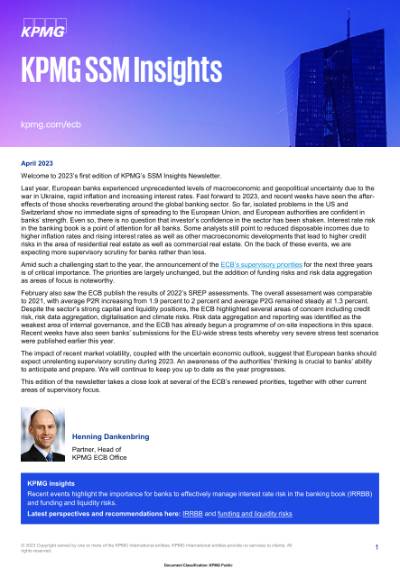April 2023
At the end of 2022 we previewed the updated methodology for this year’s European Union (EU)-wide banking stress test, which marks the first step in the European Banking Authority’s (EBA) medium-term plan to revise the stress testing framework and introduce a ‘hybrid’ approach that combines bottom-up assessments with some top-down components.
Fast forward to today, and banks are in the thick of conducting the new stress test exercise — using the scenarios announced on 31 January and additional templates released in December 2022. A significantly larger sample of banks than before — covering around 75 percent of euro area banking assets — are involved, and the forthcoming deadlines are approaching fast after the Advance Data Submission on 6 March and First Full Data Collection (FDC1) submission of projected figures due on 28 March:
- 16 May 2023 – FDC2 data due
- 28 June 2023 – FDC3 submission scheduled
- End July – publication of results anticipated
The scale of the challenges that the new test poses for banks is becoming clear.
First, the adverse scenario is, as a whole, the most severe we have seen since the EBA began conducting EU-wide stress tests. The underlying narrative assumes a major breakdown in global markets and the supply of key commodities, accompanied by high inflation, weak growth and rising interest rates. This has strong adverse effects on private consumption and investment, with corresponding implications for credit, market, counterparty and operational risks.
Some notable features of 2023’s adverse scenario include:
- A larger gross domestic product (GDP) decline from the starting point than in the 2021 scenario, with a smaller deviation from the baseline.
- For some countries and jurisdictions, an even greater hit to the value of commercial real estate (CRE) portfolios (33 percent) than in previous stress tests.
- Greater average increases in unemployment rates than in previous EBA scenarios.
- A major reduction in the economic value of the fossil fuel and energy sectors during the first two years of the scenario.
In addition, the new test makes several changes to previous methodologies. These include:
- A new requirement to provide sector-by-sector breakdowns of banks’ expected losses for non-retail exposures, based on industry-specific projections in the scenarios.
- The introduction of a prescribed set of top-down economic parameters that must be applied to projections for Net Fee & Commission Income.
- Adaptations to key templates, including non-performing loans (NPLs) and introduction of new ones, e.g. Leveraged Finance.
These features mean that 2023’s test poses some acute challenges for banks. One example is the lack of empirical data that matches the adverse scenario — there are simply no relevant historic comparatives that banks can use to model the effects of an economic crisis involving high inflation. Another set of challenges is posed by the need to adapt risk models and IT processes to collect the data required for successful completion of the new templates. Furthermore, the European Central Bank’s (ECB) late publication of benchmarking parameters is increasing the uncertainty of banks’ simulations and raises questions on the methodology and assumptions behind the benchmark values.
Once the stress test is complete, banks estimating that the adverse scenario could lead to material capital erosion should give some careful thought to stakeholder communication. Banks with material exposures to Leveraged Finance should also be aware that they might face a deep dive on this area as part of a thematic review once the ECB has completed its quality assurance (QA) of banks’ submissions.
Banks have their hands full conducting the stress test, but they should also keep one eye on the future. The EBA is continuing its work on revisions to the stress testing framework, and 2023’s test may be the last one to rely largely on bottom-up projections before more fundamental changes are introduced. Lessons learned this year could be of great value when banks come to prepare for modified stress testing in the future.
Authors
Connect with us
- Find office locations kpmg.findOfficeLocations
- kpmg.emailUs
- Social media @ KPMG kpmg.socialMedia
Stay up to date with what matters to you
Gain access to personalized content based on your interests by signing up today





